Robert Henry Buck (2 July 1881 - 9 August 1960) was an Australian pastoralist and bushman who is best remembered as being one of the people to recover the body of Lewis Harold Bell Lasseter. [1]
Contents

Robert Henry Buck (2 July 1881 - 9 August 1960) was an Australian pastoralist and bushman who is best remembered as being one of the people to recover the body of Lewis Harold Bell Lasseter. [1]

Buck was born on 2 July 1881 in Alberton in South Australia and he is the son of Robert and Sarah Ann Buck. Buck was primarily self-educated and, until 1905, worked in and around Wallaroo until he joined his uncle Joseph Breaden to work in the Northern Territory. [2]
Buck's uncle owned Todmorden, Henbury and Idracowra stations in the Northern Territory and his brother Allan, also Buck's uncle, managed Idracowra Station. Working between these stations Buck learned bushmanship and worked as a stockman and saddler. [2]
In 1907 Buck overlanded 800 head of cattle from Brunette Downs Station to Henbury Station, a journey which due to severe drought took 10 months, [3] where he became the manager. Around this period Buck partnered with Molly Tjalameinta, an Arrernte woman, and they had a daughter Ettie. [2] Buck was well respected and fondly regarded by the Aboriginal people living nearby Henbury Station and it is said he treated them well and was generous with rations compared to his contemporaries. [4]
During this period Buck frequently made lengthy visits to Hermannsburg, which was a Lutheran Mission being run by Carl Strehlow, as his daughter Ettie was living, alongside Elsie Butler, there with missionaries Emil and Clara [5] Munchenburg so that they could receive private tuition. Both girls were childhood friends of Ted Strehlow and Buck gifted Strehlow with a donkey called "possum" that would soon become a favourite pet. [6]
Buck always made his visits to Hermannsburg with Molly and many expected that the often puritanical Carl Strehlow would not approve of the pair as they were not legally married, however, he always welcomed them. Strehlow approved that Buck was faithful to Molly and looked after Ettie "like any other family man". [6]
In 1927 Buck left Henbury, and his uncles, and, in partnership with his long-term friend Alf Butler (father of Elsie), leased Middleton Ponds Station which there two would manage together until 1939. During this period Buck was also contracted to assist explorer Donald Mackay complete aerial surveys of the Northern Territory and Western Australia by assisting on the ground and working with a team of Aboriginal men and camels; Buck and his team cleared aerodromes, left supplies, guided aeroplanes with smoke-signals and many other tasks. [2]
In February 1931 Buck, alongside Johnson Breaden, Lion, Billy Button, Ernest Gustav Brandon-Cremer a paid photographer who documented the expedition as well as several other men, [7] were commissioned to search for Lewis Harold Bell Lasseter and they found and buried his body. They completed their 1000 miles journey on camel. There was suspicion at the time that Buck had not actually found the body and this brought Buck to national attention and was even travelled to Sydney to be interviewed by the media. [2]
In 1939 the Buck and Butler dissolved their partnership and Buck began managing Renner's Rock Station until he retired to Alice Springs in 1953. In Alice Springs Buck became an 'identity' at the Stuart Arms Hotel and he became a notorious yarn-spinner who told many tall stories. [2] [3]
Buck died on 9 August 1960 and is buried at the Memorial Cemetery in Alice Springs. [2]
Buck Road in Ilparpa in Alice Springs and Lake Buck in the Tanami Desert are named for him. [8] [9]
Buck also donated a photograph collection to the Northern Territory Archives Service (now: Library & Archives NT) containing photographic negatives (NTRS 4432) and prints (NTRS 1248) of the Hermannsburg and Finke regions. [10] [11]
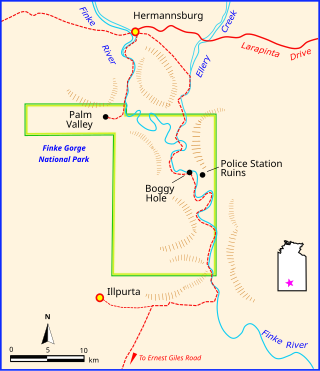
Finke Gorge National Park is a protected area in the Northern Territory of Australia located about 1,318 kilometres (819 mi) south of the territory capital of Darwin. The national park covers an area of 458 km2 (177 sq mi), and includes the desert oasis Palm Valley, home to a diverse range of plant species, many of which are rare and unique to the area. There are good opportunities for bushwalking and bushcamping in the national park.
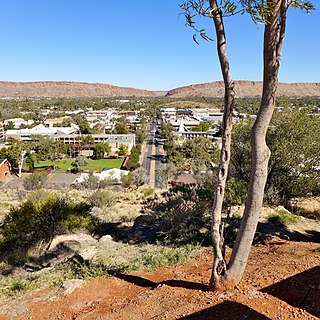
Alice Springs is a town in the Northern Territory, Australia; the third largest settlement after Darwin and Palmerston. The name Alice Springs was given by surveyor William Whitfield Mills after Alice, Lady Todd, wife of the telegraph pioneer Sir Charles Todd. Known colloquially as "The Alice" or simply "Alice", the town is situated roughly in Australia's geographic centre. It is nearly equidistant from Adelaide and Darwin.
Lasseter's Reef refers to the purported discovery, announced by Harold Bell Lasseter in 1929 and 1930, of a fabulously rich gold deposit in a remote and desolate corner of central Australia. Lasseter's accounts of the find are conflicting and its precise location remains a mystery—if it exists.

Hermannsburg, also known as Ntaria, is an Aboriginal community in Ljirapinta Ward of the MacDonnell Shire in the Northern Territory of Australia, 125 kilometres (78 mi); west southwest of Alice Springs, on the Finke River, in the traditional lands of the Western Arrarnta people.
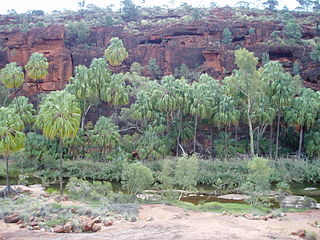
Palm Valley, within the Finke Gorge National Park, is an east-west running valley in the Krichauff Range 123 km southwest of Alice Springs in the Northern Territory, Australia. Palm Valley and the surrounding area is the only place in Central Australia where Red Cabbage Palms survive. The nearest related species is 850 kilometres away in Katherine NT. The surrounding region is largely dry Central Ranges xeric scrub.
Carl Friedrich Theodor Strehlow was an anthropologist, linguist and genealogist who served on two Lutheran missions in remote parts of Australia from May 1892 to October 1922. He was at Killalpaninna Mission in northern South Australia, from 1892 to 1894, and then Hermannsburg, 80 miles (130 km) west of Alice Springs, from 1894 to 1922. Strehlow was assisted by his wife Friederike, who played a central role in reducing the high infant mortality which threatened Aboriginal communities all over Australia after the onset of white settlement.

The Arrerntepeople, sometimes referred to as the Aranda, Arunta or Arrarnta, are a group of Aboriginal Australian peoples who live in the Arrernte lands, at Mparntwe and surrounding areas of the Central Australia region of the Northern Territory. Many still speak one of the various Arrernte dialects. Some Arrernte live in other areas far from their homeland, including the major Australian cities and overseas.

Lewis Harold Bell Lasseter, also known as Harold Lasseter, was an Australian gold prospector who claimed to have found a fabulously rich gold reef in central Australia.
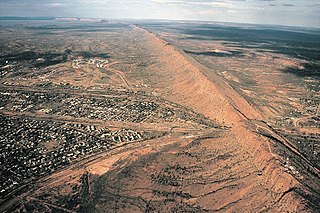
The Heavitree Gap, or Ntaripe in the Arrernte language, is a water gap in the Northern Territory of Australia in the MacDonnell Ranges. It is the southern entrance to the city of Alice Springs and in addition to the Todd River it carries the main road and rail access to the south.

Haasts Bluff, also known as Ikuntji, is an Aboriginal Australian community in Central Australia, a region of the Northern Territory. The community is located in the MacDonnell Shire local government area, 227 kilometres (141 mi) west of Alice Springs. At the 2006 census, the community, including outstations, had a population of 207.
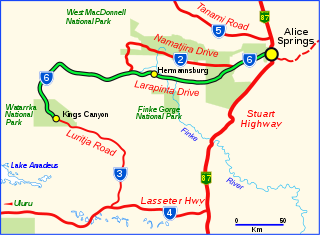
Larapinta Drive is a designated state route in the Northern Territory of Australia.

Henbury Station is a cattle station in the Northern Territory of Australia. In March 2022 Henbury was purchased by Tim Edmunds for A$32 million, including its 3500 cattle.
Walter Smith also known as Walter Purula (Perrurle) or Wati Yuritja was a legendary Australian bushman from the Arltunga region in the Northern Territory of Australia. Wati Yuritja translates as man of the Water Dreaming).
Ghan is a locality in the Northern Territory of Australia located about 1,470 kilometres (910 mi) south of the territory capital of Darwin at the intersection of Lasseter Highway and Stuart Highway.

Gerhardt Andreas Johannsen was a stonemason, builder and pastoralist in the Northern Territory.
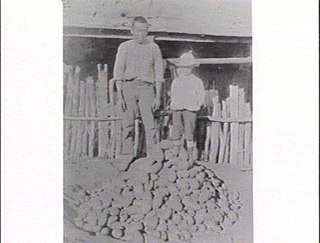
Ah Hong was a Chinese market gardener who spent most of his life in Alice Springs, and was a well regarded figure in an era of considerable prejudice towards Chinese people in Australia.
The Charles River, which is often called Charles Creek is an ephemeral stream in the southern Northern Territory. It is a tributary of the Todd River and, like the Todd River, its naming is associated with Charles Todd; a senior civil servant involved with the Overland Telegraph Line.

Honeymoon Gap is a small gap 1 km south of Larapinta Drive, 14 km west of Alice Springs, on Roe Creek, 8 km south of where it cuts through Simpsons Gap. The Arrernte name for the Gap is Angatyepe and it is associated with Perentie (Goanna) Dreaming. There is an outstation nearby that shares this name nearby.
Friedrich Wilhelm Albrecht was a Lutheran missionary and pastor who was the superintendent at Hermannsburg Mission in Central Australia from 1926 to 1952 where he made a significant contribution.
John Strehlow is an Australian stage director, playwright, and author. He is known for his workThe tale of Frieda Keysser: Frieda Keysser & Carl Strehlow, an historical biography, about his grandparents, Lutheran missionaries Carl and Frieda Strehlow, who served for many years at Hermannsburg Mission in the Northern Territory.